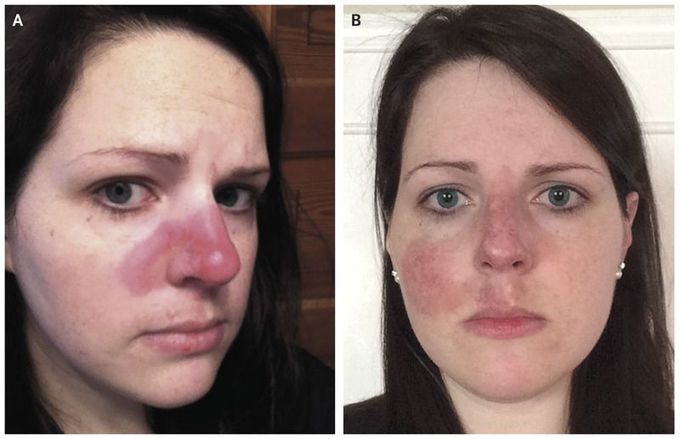


Cutaneous Lupus — “The Pimple That Never Went Away”
A 28-year-old woman presented with an erythematous rash involving the nose, nasolabial folds, and philtrum that appeared after she had manipulated a painful vesicular lesion at the base of her nose that she believed to be a pimple. The patient received cloxacillin for presumed erysipelas and had a partial response. However, after cloxacillin therapy, worsening induration (Panel A) prompted treatment with intravenous antibiotics, which had no effect. The patient reported recent sun exposure before noticing the extent of the symptoms. Subsequent laboratory tests were positive for antinuclear antibodies, anti-Ro antibodies (antibody index, 2.7 [normal, <1.0]), and anti-La antibodies (antibody index, >8.0 [normal, <1.0]) and showed a C3 level of 1.13 g per liter (normal, 0.79 to 1.52) and a C4 level of 0.17 g per liter (normal, 0.16 to 0.38). A punch biopsy specimen of skin from the right cheek showed vacuolar interface dermatitis and perivascular and perifollicular lymphocytic infiltration of the dermis — features that are consistent with discoid lupus erythematosus, a type of cutaneous lupus erythematosus. Cutaneous lupus erythematosus is often provoked by exposure to sunlight; the rash typically extends from the cheeks over the bridge of the nose and spares the nasolabial folds. This patient received treatment with oral prednisone and hydroxychloroquine, and the rash became less prominent, with only residual skin pigmentation (Panel B).
Living with Lupus is often a battle not just against the illness itself, but also against the emotional weight of uncertainty, fatigue, and the toll of long-term medications. For one courageous woman, that battle began in 2013. Diagnosed after Lupus had already affected her joints and internal organs, she was quickly placed on medication that initially helped. But as time went on, her health declined again this time with more frequent flare-ups and increasingly difficult side effects. Like many others with chronic illness, she faced the crushing weight of hopelessness. Each day became harder than the last, and conventional treatments no longer offered the comfort they once did. But in March 2020, at her lowest point, she made a decision that changed everything.Out of desperation and with a healthy dose of skepticism she turned to NaturePath Herbal Clinic, hoping their natural Lupus treatment might offer at least some relief. What happened next went far beyond her expectations.After completing a six-month herbal program, her flare-ups stopped entirely. Her energy returned. The chronic pain that had defined her daily life began to fade. For the first time in years, she felt like herself again. Not just alive but truly living.Her story is not just one of healing; it’s one of resilience, open-mindedness, and the courage to try something new when all else fails. By sharing her journey, she hopes to offer something priceless to others living with Lupus: hope.This treatment has been a true breakthrough for her. If you’re searching for a safe, natural, and effective alternative, I genuinely recommend giving this a chance.”www.naturepathherbalclinic.com or email them at info@naturepathherbalclinic.com


